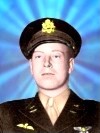John C. Morgan
John C. Morgan
Bombing Berlin
“Hitler built a fortress around Europe, but forgot to put a roof on it.”
President Franklin D. Roosevelt
 The thousands of small steel fragments sounded like hail as they rained on the thin metal of the B-17 Flying Fortresses that droned ever closer to their target four miles below. Inside them, the aircrews were busy at their guns–it seemed that enemy fighters were everywhere. The pilots struggled to keep their bombers on course despite the thick anti-aircraft fire. It was the heaviest any of them had ever seen, later described by one veteran of the raid as being “so thick a man could walk on it.”
The thousands of small steel fragments sounded like hail as they rained on the thin metal of the B-17 Flying Fortresses that droned ever closer to their target four miles below. Inside them, the aircrews were busy at their guns–it seemed that enemy fighters were everywhere. The pilots struggled to keep their bombers on course despite the thick anti-aircraft fire. It was the heaviest any of them had ever seen, later described by one veteran of the raid as being “so thick a man could walk on it.”
The level of enemy resistance was not surprising. The inbound flight of B-24 and B-17 bombers from the Mighty Eighth (Air Force) numbered 660 strong. They were escorted by scores of P-51 fighters, making the formation a hard target to miss.
The American airmen were confronted in the sky by hundreds of German FW-190s and ME-109s. The heavens were literally filled with airplanes, flaming tracers, exploding flak, and occasionally, the distinctive white canopy of a parachute. The date was March 6, 1944, and for the first time, American bombers were making a daylight attack at the heart of Hitler’s Fortress Europe.
This was the mission everyone had faced with a mixture of fear and anticipation. Before the war began German Reichmarshal Hermann Goering had proudly boasted, “No bomb shall fall on German soil.” On January 27, 1943, pilots of General Ira Eaker’s Mighty Eighth accepted Goering’s challenge and dropped their bombs on enemy submarine pens at the Wilhelmshaven Naval Base in northern Germany. Undeterred, Reichmarshal Goering reassured his nation that it was immune to attack from afar. “No enemy bomber can reach the Ruhr. If one reaches the Ruhr, my name is not Goering. You may call me Meyer.” he boasted.
On this date, after two days of attempts that had been thwarted by poor weather, American pilots filled the skies to drop more than 1,600 pounds of bombs on The Big “B” – Berlin. Going in, every man knew it would be rough, certainly one of the most dangerous air missions flown yet in the war. Enemy fighters would duel to the death to defend their capital. Certainly, Hitler’s ground defenses would be heavy, and the batteries would be manned by the very best gunners the Reich could muster.
The mission was akin in both dangers and in design to a mission flown by twenty-six B-25 bombers just two years earlier when Colonel Jimmy Doolittle struck the heart of Japan, proving to Emperor Hirohito that Tokyo was not immune to attack. Ironically, it was Lieutenant General Jimmy Doolittle who now commanded the Mighty Eighth and who directed this mission.
Doolittle had requested permission to fly with his men. “I wanted to be in on this first effort and have the honor of being the first air commander to lead a raid over all three Axis capitals,” he wrote in his autobiography. (Following the Tokyo raid, on July 19, 1943, Doolittle had led a bombing raid over Rome.)
Doolittle initially convinced General Harold Tooey Spaatz to allow him to fly a P-51 on the Berlin raid, but on the day before it was to commence, “Tooey changed his mind and said he couldn’t afford to risk the capture of a senior officer who had knowledge of invasion plans. I have always suspected that when Ike (General Dwight Eisenhower) heard about it, it was he who canceled the idea…although Tooey never said he did.”
If indeed it was General Eisenhower who refused to let his top commander in the 8th Air Force fly the first daylight bombing raid over Berlin, it was a wise choice. Everyone realized the mission would be costly–and it was. Before the day ended at least eighty American aircraft went down, including sixty-nine bombers.
In the lead B-17, Lieutenant John C. Red Morgan felt his own bomber bounce with an endless series of explosions that seemed to fill the sky. In twenty-five previous missions he had never seen so much anti-aircraft fire. To make matters worse, the German gunners on the ground were indeed some of Hitler’s best. Their accuracy was taking its toll.
Morgan was nearing the target and through his cockpit window, he could look down to see the city of Berlin 20,000 feet below. Men scurried about inside the Flying Fortress to both defend it and to prepare for the bomb run. Explosions continued to buffet the bomber and the rain of shrapnel pattered against its skin, but this was nothing new for a combat veteran like Lieutenant Morgan.
Twice before the lanky Texan had been highly decorated for bringing home a shot-up Fortress. Morgan knew these big bombers could handle a lot of damage and still return safely home. For this reason, he didn’t bother to divert his attention from the tasks at hand, even to secure his chest-pack parachute in place over his uniform.
And then….it was too late!
The huge Flying Fortress shuddered under a deadly blast from the ground that ripped through metal and shredded control lines. The freezing wind rushed into the fuselage through gaping holes and smoke billowed around the crippled bomber. A fuel tank was hit and quickly caught fire. Morgan fought to bring the bomber under control but the damage was too severe. The intrepid airmen refused to give up his ship, even when it began tumbling out of control and falling towards earth.
If not for the explosion, Lieutenant Morgan might well have remained at the controls all the way to the ground, struggling to save his airplane. Instead, the blast opened up the big Fortress like a cavern and propelled Morgan into the open air. Somehow, as he felt his body being forcibly ejected, he managed to reach out and grab his loose parachute and clutch it tightly beneath his arm. Later, newspaper accounts called the next few minutes: “one of the most spectacular free falls in history.”
Plummeting earthward with flak still bursting and his parachute still unsecured, John Cary Red Morgan wasn’t yet ready to die. “I didn’t think I was dead,” he recalled of that moment. “There was no question about it. Strangely, when you are in that situation you are no longer afraid. I have found that the unknown is usually the most frightening.” With the frigid wind whipping through his uniform and restraining his movement, and while the ground continued to rush ever closer, the intrepid airman set himself to the daunting task of strapping on his chute and securing it in his chest harness. With only about 500 feet of air remaining between him and imminent death, the chute was in place and Morgan pulled the D-ring. Silk billowed above him, his descent slowed, and the immediate danger was behind.
Floating almost peacefully towards earth, however, more danger remained below. Lieutenant Morgan had bailed out over Berlin and the Germans were waiting for him to touch down. It was an ironic fate for a man who had been deemed physically unqualified for military service by his own country and had then gone on to fly missions for three different Allied nations. Morgan had proved his courage repeatedly through twenty-five missions, only to fall into enemy hands on this, his twenty-sixth. What made his situation even more unusual, on a mission less than a year earlier Lieutenant had performed with such heroism that his nation had awarded him its highest military honor.
Lieutenant John Cary Red Morgan was about to become the first recipient of the Medal of Honor to be captured by the enemy.
This electronic book is available for free download and printing from www.homeofheroes.com. You may print and distribute in quantity for all non-profit, educational purposes.
Copyright © 2018 by Legal Help for Veterans, PLLC
ALL RIGHTS RESERVED

